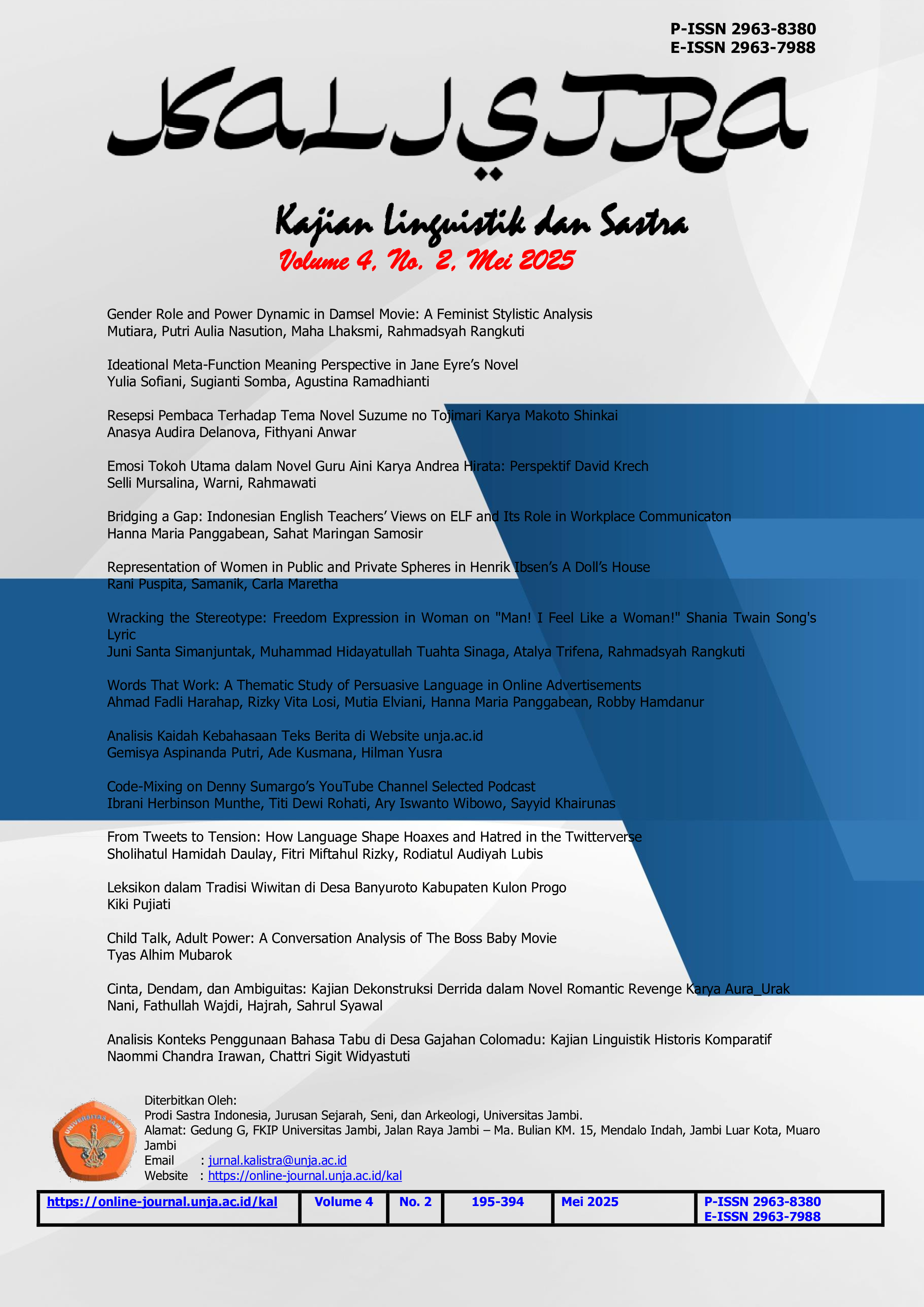Analisis Perbandingan Karakter Genre pada Platform Wattpad dan Fizzo: Analisis Sastra PopulerJudul Artikel
DOI:
https://doi.org/10.22437/kalistra.v4i2.45022Keywords:
whattpad, genre romansa, sastra, populerAbstract
This article discusses the comparative characteristics of the romance genre on two popular digital media platforms, Wattpad and Fizzo. Using a descriptive qualitative approach and John G. Cawelti's formula genre theory and Burhan Nurgiyantoro's structural characterization theory, this study aims to identify differences in plot formulas, characterization of female protagonists, and narrative themes. Wattpad tends to feature strong female characters and reflective and innovative narratives, while Fizzo maintains a conventional romance structure with subordinate female characters and male dominance as saviors. These findings show that reader preferences and market strategies help shape the romance genre in popular digital literature.
Abstrak
Artikel ini membahas perbandingan karakteristik genre romansa pada dua platform media digital populer, Wattpad dan Fizzo. Dengan menggunakan pendekatan kualitatif deskriptif dan teori genre formula dari John G. Cawelti serta teori struktural penokohan Burhan Nurgiyantoro, penelitian ini bertujuan mengidentifikasi perbedaan formula alur, karakterisasi tokoh utama perempuan, dan tema naratif. Wattpad cenderung menampilkan tokoh perempuan kuat dan narasi yang reflektif serta inovatif, sementara Fizzo mempertahankan struktur romansa konvensional dengan tokoh perempuan subordinatif dan dominasi laki-laki sebagai penyelamat. Temuan ini memperlihatkan bahwa preferensi pembaca dan strategi pasar turut membentuk genre romansa dalam sastra digital populer.
Downloads
References
Budijanto, J. B., & Dewi, N. (2022). Perbandingan genre sastra populer dan pengajarannya pada siswa sekolah menengah atas. Diglosia, 6(1), 148–160.
Cindy Mutia Annur. (2023). No Title Pengguna TikTok di Indonesia Terbanyak Kedua di Dunia per April 2023, Nyaris Salip AS? Kata Data. https://databoks.katadata.co.id/datapublish/2023/05/24/pengguna-tiktok-di-indonesia-terbanyak-kedua-di-dunia-per-april-2023-nyaris-salip-as
Cinthya, N., & Wati, R. (2020). Fenomena Sastra Cyber: Trend Baru Sastra Islami Dalam Masyarakat Modern Di Indonesia. Jurnal Edukasi Khatulistiwa : Pembelajaran Bahasa Dan Sastra Indonesia, 3(1), 1. https://doi.org/10.26418/ekha.v3i1.37991
Dewi, Desyarini Puspita, H. G. D. (2021). Maskulinitas Dalam Novel Bumi Manusia. Jurnal Parafrasa: Bahasa, Sastra Dan Pengajaran, 3(1), 9–14.
Nisa, K. (2018). Analisis Kesalahan Berbahasa Pada Berita Dalam Media Surat Kabar Sinar Indonesia Baru. Jurnal Bindo Sastra, 2(2), 218. https://doi.org/10.32502/jbs.v2i2.1261
Noor, R., Waluyo, S., & Setyadi, A. (2022). Formula Struktur Novel Populer Indonesia Periode 1970-1980. Jurnal Ilmiah Kajian Antropologi, 5(2), 114–122.
Nurhidayah, S., & Setiawan, R. (2019). Lanskap Siber Sastra: Postmodernisme, Sastra Populer, Dan Interaktivitas. Poetika, 7(2), 136. https://doi.org/10.22146/poetika.v7i2.50779
Rahadi, D. R. (2020). Konsep Penelitian Kualitatif,. In PT. Filda Fikrindo (Issue September).
Ricky A Manik, Arif, J., & Hakim, R. (2018). Ideologi Kapitalisme Dalam Kepopuleran Sang Pemimpi Capitalism Ideology In The Popularity of Sang Pemimpi. 101, 61131.
Salmaa. (2023). Kerangka Berpikir: Cara Membuat dan Contoh Lengkap. In Deepublish (p. 1). https://penerbitdeepublish.com/kerangka-berpikir/
Yanti, P. G. (2021). Sastra Digital Dan Keunggulannya. Prosiding Samasta, 945–950.
Yoesoef, M. (2020). Cyber Literature: Wattpad and Webnovel as Generation Z Reading in the Digital World. 453(Inusharts 2019), 128–131. https://doi.org/10.2991/assehr.k.200729.025
Yusanta, F. B., & Wati, R. (2020). Eksistensi Sastra Cyber: Webtoon Dan Wattpad Menjadi Sastra Populer Dan Lahan Publikasi Bagi Pengarang. Jurnal LITERASI, 4(April), 1–7.
Downloads
Published
How to Cite
Issue
Section
License
Copyright (c) 2025 Ninik Diana Lestari

This work is licensed under a Creative Commons Attribution-ShareAlike 4.0 International License.
Kalistra: Kajian Linguistik dan Sastra is licensed under Creative Commons Attribution-ShareAlike 4.0 International License.
Authors who publish their manuscripts in Kajian Linguistik dan Sastra agree to the following terms:
1. The copyright in each article belongs to the author.
2. The author acknowledges that Kajian Linguistik dan Sastra reserves the right to be the first to publish under a Creative Commons Attribution-ShareAlike 4.0 International License (Attribution 4.0 International CC BY-SA 4.0).
3. Authors may submit articles separately, arranging for non-exclusive distribution of manuscripts that have been published in this journal to other versions (e.g., delivery to the author's institutional repository, publication into a book, etc.), acknowledging that the manuscript has been first published in Kajian Linguistik dan Sastra.
















